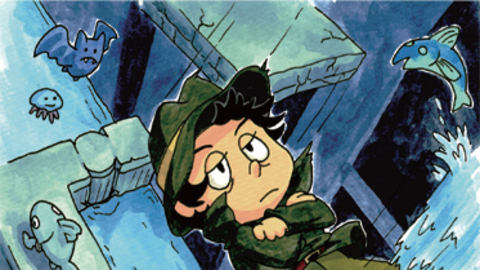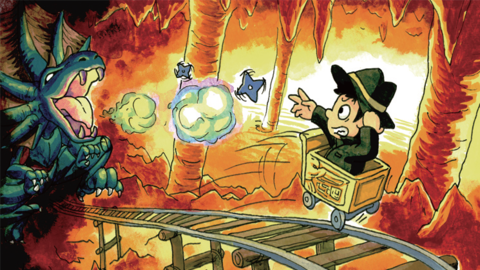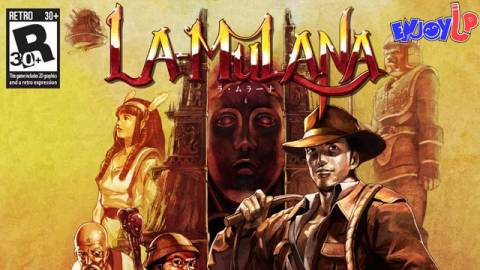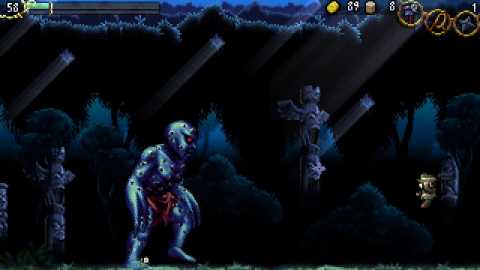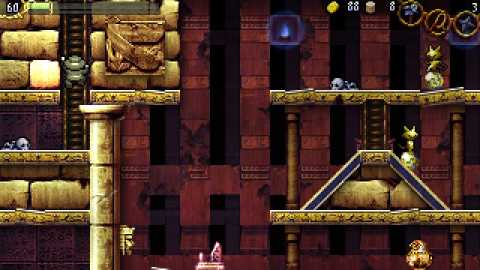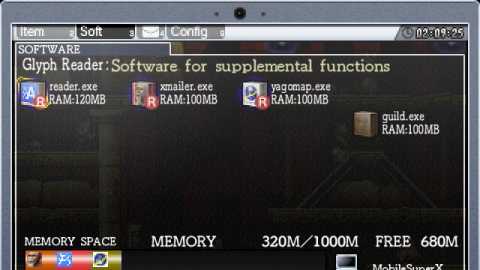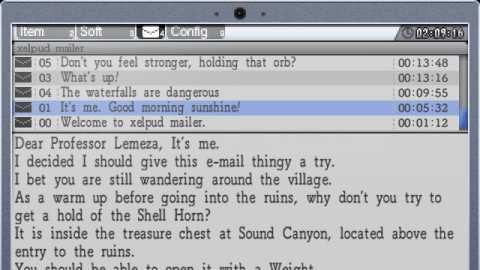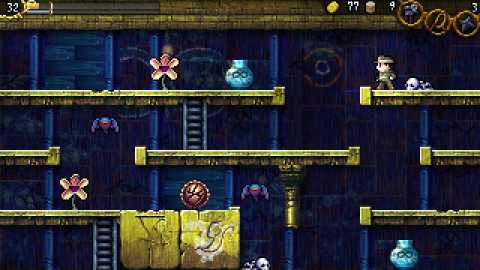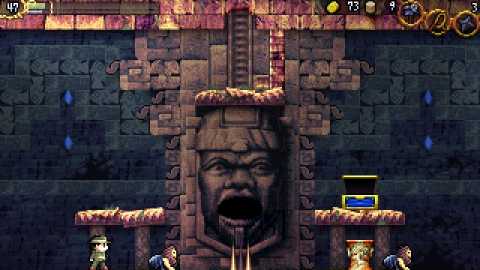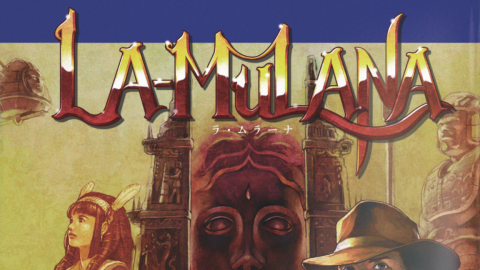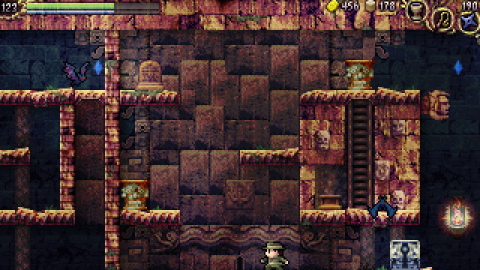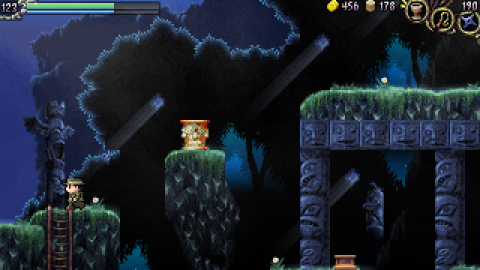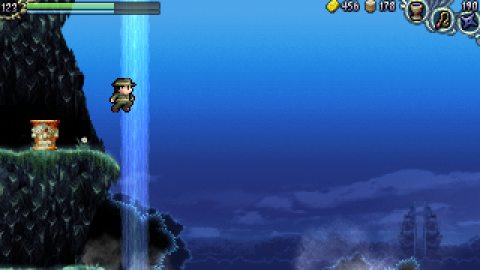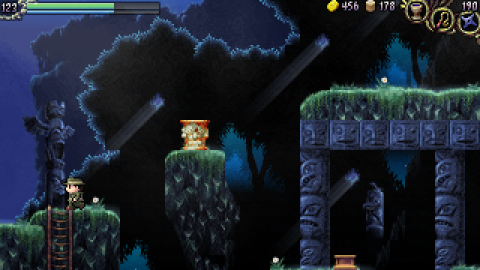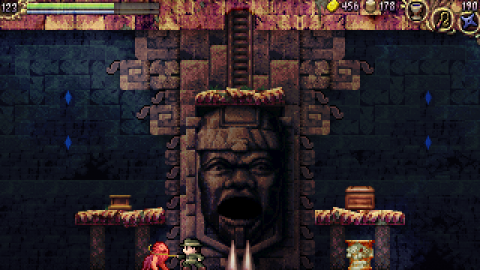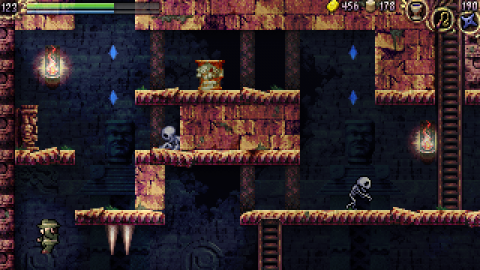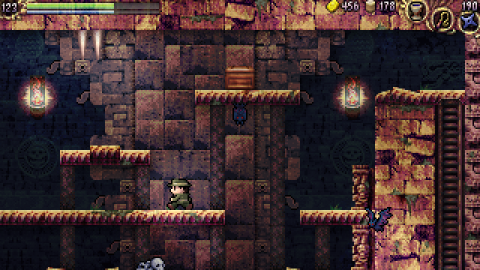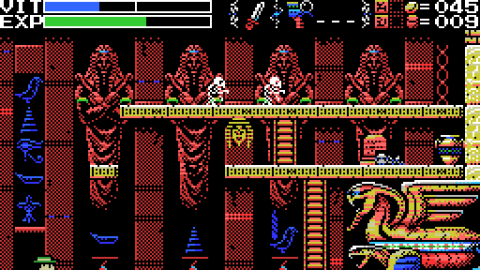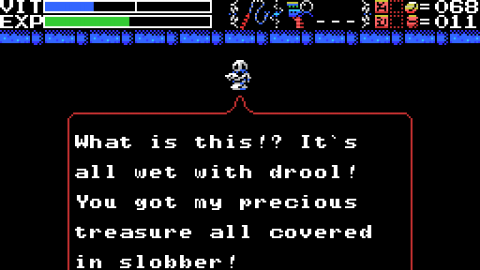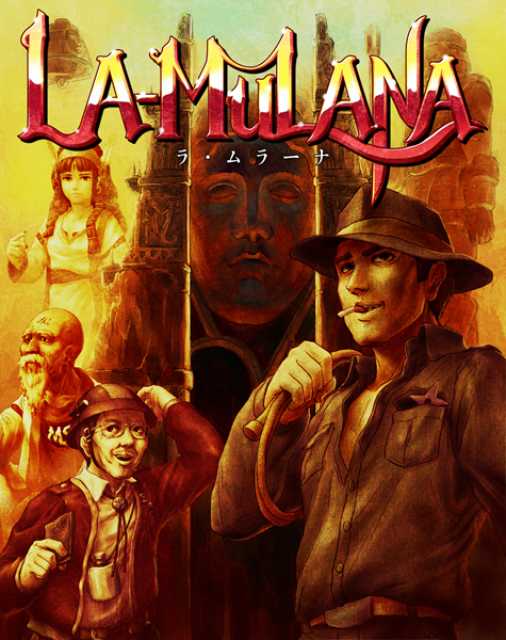Overview
La Mulana is a freeware Metroidvania style platformer released in 2005 for the PC. The game was intended as a tribute to the MSX and was primarily inspired by MSX game Maze of Galious. The game was also designed to remind players the era of difficult 8-bit games, and is thus known both its difficulty as a platformer, its difficult puzzles, and its lack of guidance to the player. The game was originally only released in Japan, but an English translation patch is now available. The freeware version and translation patch may be found in a zip file located here.
A WiiWare remake with updated graphics, lowered difficulty, and other modifications was released in Japan in 2011 with a localization for western markets in the works that was supposed to be published by Nicalis but due to the long development time to pass Nintendo of Europe/America's certification process, Nicalis stepped back from their publishing agreement. Nigoro, developer of the remake version, eventually announced that the remake would be available on July 13, 2012 for PC via Playism (playism-games.com), a digital distribution service for indie games. In a statement, Nigoro promised they are still attempting to release the WiiWare version in western territories but that version would not include the DLC features like the Hell Temple when it gets released. On August 29 2012, it was revealed on Nintendo's US-website that La-Mulana would finally make its way onto the North American and European WiiWare service via publisher EnjoyUp on September 20, 2012 for 1000 Nintendo Points.
Plot
La Mulana follows the trail of Lemeza, an Indiana Jones-style explorer entering the ruins of La Mulana after receiving a mysterious note from his long-missing father Shorn. As he explores La Mulana, Lemeza learns more of the ruins, its guardians, and its inhabitants, and is presented with an ultimate task to complete.
Gameplay
La Mulana plays much like traditional Metroid and Castlevania style games. The character begins only with a whip and very low amount of life. As the player explores he gains more life and gathers new weapons, projectile subweapons, and equipment. Much like the original Metroid, upon entering the ruins of La Mulana the player is given little guidance as to where to go or what to do. While certain equipment is often necessary to proceed at times, the game is open-ended and allows the player to freely explore the many areas of the ruins. Usually there is no obvious route for the player to take or proper sequence for challenges to be completed in.
Known for its difficulty, La Mulana is filled with puzzles, traps, dead-ends, annoying enemies, and challenging bosses. Many of the puzzles are solved by reading various tablets around the ruins which have hint text or pictures written on them. The skeletons of previous failed explorers can also provide guidance if examined. Doors may also be entered containing advice-providing creatures or shops, similar to the original Zelda. Due to the game's difficulty often players must explore and solve as much as they can before retreating to the entrance to save and restore their life. An item is gained early on which allows teleportation among visited areas and back to the entrance, encouraging just such a tactic.
The game also scattered various MSX "Roms" hidden throughout the ruins, most representing old MSX games. Many of these roms are just useless collectibles, while others provided bonuses, abilities, or easter eggs if used by the player. A smaller fraction of roms are necessary tools for the player, providing the ability to translate text in the ruins, teleport to parts of the ruins, or even save the game. The player starts the game with an MSX computer which may run roms, and may be upgraded with a handi-scanner for reading and dual cartridge capability for running rom combinations.
While exploration, equipment gathering, and puzzle solving are the primary motivations for the player, La Mulana also contains an overarching plot to be revealed and challenge to be completed by the player. Each area contains a boss to be unlocked and beaten and a series of final challenges and puzzles will unlock a final boss. However, even after the ending there are a series of even more gruesome challenges, appropriately entitled the Hell Temple, available for the player to conquer.
Locations
Surface - The starting area of the game. Location of the village Elder who provides advice and comments on old MSX games. The Elder also allows the player to save the game if the Game Master Rom is equipped. Also has several shops, hidden items, and the entrance to the ruins of La Mulana.
Aside from the Surface, each area contains a "Frontside" and a "Backside" version which are often interconnected. Many of the Frontside areas can be explored initially by the player, while the Backside areas often need to be unlocked. While the areas are numbered by the game, there are numerous passages between them and there is no set order for exploring them.
Each Backside/Frontside pair of areas contain a Life Jewel which expands the player's life bar, an Ankh Jewel which is used to unlock one of the eight Guardians, and a Guardian to be unlocked and defeated in the Frontside area.
Frontside Areas
Guidance Gate - Initial area connected to the Surface. Contains advice for beginners, and introductions to the puzzles, traps, and general gameplay of La Mulana. Importantly contains the Shiruken subweapon and the Grail, which allows for teleportation to the Surface initially and the areas of the ruins later after certain tablets are decoded.
Mausoleum of the Giants - Usually the second area to be entered. Primarily centers around the race of the Giants, whose stories can be discovered by reading the tablets within. Contains the Throwing Knife subweapon.
Temple of the Sun - Usually the third area to be entered. Has an obvious Egyptian motif, including a huge pyramid-shaped temple at its center. Important items include the Knife, and the speed-enhancing Boots.
Spring in the Sky - Usually the fourth area to be entered. Filled with water, which initially damages the player to swim in, and waterfalls, which force downward players not wearing a Helmet. Also contains the Scalesphere, which allows for travelling underwater, and the first of four Seals, which are necessary to unlock many things within the ruins.
Inferno Cavern - Usually the fifth area to be entered. Filled with lava which is damages the player to swim in until an item is obtained which protects from lava. Noteworthy items include the a more powerful Whip, the Flare Gun subweapon, and the wall-clinging Grapple Claw.
Chamber of Extinction - Usually the sixth area to be entered. Has one section which is cloaked in darkness until the player solves a puzzle in the backside version of this area.
Twin Labryinths - The seventh area and the only one without a true "backside" version. Instead, this area contains a left and right side which are mirror images of one another, representing the front and back. Initially very little of this area can be explored. The Twin Statue must be obtained in order to solve a puzzle which lifts a cloud of poison gas over the rest. Contains the Katana weapon and the Comic Bakery Rom, which together with the Antarctic Adventure Rom allows for teleportation to backside areas.
Endless Corridor - The eighth area of the ruins. Notable for its pots emblazoned with the infinity symbol, this area consists of five corridors which wrap around back to the beginning after you travel far enough through them. The Endless Key must be obtained to travel beyond the first corridor, and the remaining corridors must be unlocked through a series of tricky puzzles and challenges. At the bottom of the last corridor lies an entrance to the final area.
Shrine of the Mother - The ninth and final area of the ruins. Contains many of the final plot-driving items in the game. This area only exists until all eight Guardians are defeated, at which point it transforms into its alternate form.
Backside Areas
Confusion Gate - Backside version of the Guidance Gate. Notorious for its many hidden passages and ladders, teleports and dead-ends, and tablets which enjoy mocking the player. Requires much backtracking and puzzle solving to be fully explored.
Graveyard of the Giants - Backside version of the Mausoleum of the Giants. Covered in ice for the most part, making running, jumping, and grappling fairly difficult. Contains the Bomb subweapon, the Silver Shield, and an attack speed increasing Gauntlet.
Temple of Moonlight - Backside version of the Temple of the Sun. Filled with many moving platforms and lizards which blend into the background. Also contains an inverted temple which functions as the mirror image of the temple in the frontside area. Notable items include the Axe and the lava-proof Ice Cape.
Tower of the Goddess - Backside version of the Spring in the Sky. Mostly consists, not surprisingly, of towers to be scaled by the players. Contains the stretch of the game widely considered to the most difficult standard area in the game, a long tower climb that must be done using the Grapple Claw. Also contains enemies which are initially invisible to the player. The final whip upgrade, the Mace, is located here.
Tower of Ruin - Backside version of the Inferno Cavern. Has a destroyed future motif to it. Contains the Spear subweapon, among other items.
Chamber of Birth - Backside version of the Chamber of Extinction. Has elements from both Hebrew and Hindu culture within. Another confusing area which requires liberal use of hidden teleports and passages to travel through. Contains many plot-important items, as well as a puzzle which will light up the darkened area of the Chamber of Extinction.
Dimensional Corridor - Backside version of the Endless Corridor. Unique in that while often considered the backside, the game's story describes the area as being the frontside, warped by the powerful magic of the area's Guardian, Tiamat. This area contains eleven sub-bosses which must be defeated to confront Tiamat. In addition, once the player travels into this area the only way out is through a one-way door, as use of the Grail is blocked within.
True Shrine of the Mother - Alternate version of the Shrine of the Mother. The Shrine of the Mother transforms into this once all eight Guardians are defeated. The transformation removes many of the items within, however, so the player must be sure to fully explore the original Shrine of the Mother before defeating the eight Guardians. The True Shrine contains the final boss of the game, who may be unlocked through a long series of steps.
Optional Area
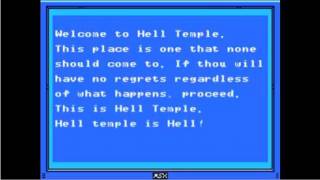
Hell Temple - The appropriately titled optional area of the game, which may be unlocked through a convoluted and walkthrough-required set of steps available after going through the main plot of the game. Hell Temple pulls no punches in attempting to destroy the player's sanity. Notable challenges include fake platforms, pits and ladders which will send you back to the start, and combinations of the hardest enemies from the game itself. It is most likely one of the hardest video game challenges available. Attempt at your own risk.
Remake
A new version with updated graphics and mechanics was published on the Japanese WiiWare shop in June 2011 and later ported to PC. Some of the changes in the new version include:
- A redesign of the MSX rom system featuring a design for a more modern laptop computer titled the MobileSuperX. Many programs may be running/equipped at once depending on the memory limit of the model. (This incorporates the removal of the collectible MSX roms for obvious copyright reasons.)
- Lowered difficulty of certain areas, such as the tower climb in the Tower of the Goddess.
- Increasing the ease of use of certain items, such as the grapple claw.
- Making certain puzzles easier to solve and providing additional hints to the player on where to go or what to do.
- Updated graphics and music, changing from old 8-bit style and midi music.
- New subweapons, areas, and enemies.
System Requirements (PC)
Minimum
- OS : Windows XP / Vista / 7
- Processor : 2 GHz processor
- Memory : 1 GB RAM
- Graphics : 3D graphics card compatible with DirectX 9.0c, 128 MB VRAM
- Hard Drive : 187 MB available space

 Mac
Mac Wii Shop
Wii Shop PC
PC PlayStation Vita
PlayStation Vita.png) PlayStation Network (Vita)
PlayStation Network (Vita) Xbox One
Xbox One PlayStation 4
PlayStation 4 Linux
Linux